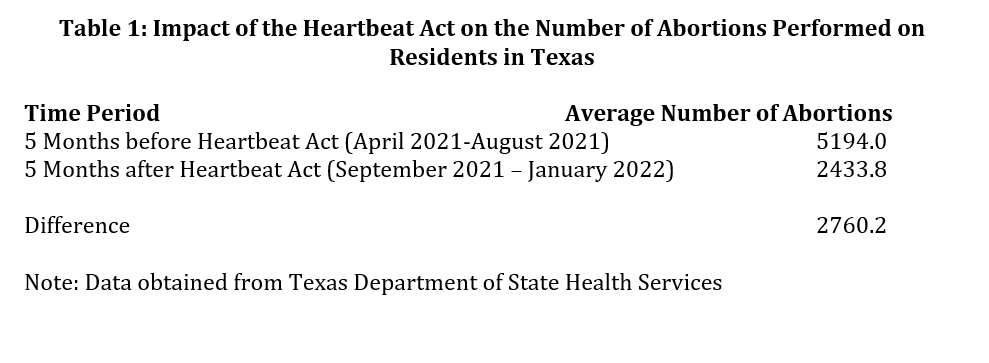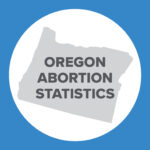Texas’ Gain: The Lifesaving Impact of the Texas Heartbeat Act

This is Issue 90 in the On Point Series.
Executive Summary
On September 1, 2021, the Texas Heartbeat Act took effect.[i] This legislation protects preborn children in Texas after a heartbeat is able to be detected, which science has proven can happen as early as the sixth week of gestation.[ii] This marked the first instance since the Supreme Court’s 1973 Roe v. Wade decision that a law protecting preborn children well before viability was implemented. The impact of this law has been disputed.[iii] However, an analysis of newly published Texas birth data shows that between March 2022 and July 2022, the number of births in Texas increased by more than 5,000 as compared to identical time periods from previous years. This review of newly available state birth data provides a compelling indication that the Texas Heartbeat Act has already played a vital role in saving thousands of lives in the Lone Star state.
Background of the Texas Heartbeat Act
Passing a law that would protect preborn children after a fetal heartbeat can be detected has been a longtime priority for many pro-life Texas state legislators. In 2013, a six-week abortion ban, HB 59, was introduced by state representative Phil King.[iv] That bill did not pass. In 2019, another six-week abortion ban, HB 1500, was jointly introduced by state representatives Briscoe Cain, Phil King, Dan Flynn, Tan Parker, and Rick Miller.[v] HB 1500 was sponsored or cosponsored by at least 57 of the 150 members of the Texas House of Representatives.[vi] However, like HB 59, HB 1500 failed to pass.[vii]
On March 11, 2021, the Texas Heartbeat bill, SB 8, was introduced by State Senator Bryan Hughes.[viii] The next day, a companion bill, HB 1515, was filed by State Representative Shelby Slawson in the Texas House of Representatives.[ix] SB 8 was reported favorably by the Senate State Affairs Committee in March by a 7-2 margin[x] and HB 1515 was reported favorably by the House Public Health Committee in April by a 6-4 margin.[xi] HB 1515 passed the Texas State House on May 6th[xii] and SB 8 passed the Texas State Senate on May 13th.[xiii] Texas Governor Greg Abbott signed the Texas Heartbeat Act into law on April 19, 2021.[xiv]
The Texas Heartbeat Act successfully withstood several legal challenges from plaintiffs including abortion facilities, organizations supporting legal abortion, and even the U.S. Department of Justice.[xv] The enacted law took effect September 1, 2021.[xvi] This was the first time since the Supreme Court’s 1973 Roe v. Wade decision that a law protecting preborn children well before viability was in effect for an extended period of time.
Impact of the Texas Heartbeat Act
In the months following the law’s enactment, there was a notable reduction in the number of abortions performed in the Lone Star State. Between August 2021 and September 2021, the number of abortions in Texas declined by 3,455 (Figure 1).[xvii] Overall, in the five months after the enforcement of the Texas Heartbeat Act, the average monthly number of abortions performed in Texas declined by more than 2,760 (Table 1).


However, comparing abortion averages from the five months after the enforcement of the Texas Heartbeat Act to the five months prior to the enforcement of the Texas Heartbeat Act may not be the most accurate method to analyze the impact of the law. The incidence of abortion fluctuates on a monthly basis. Past data from the Texas Department of State Health Services indicates that significantly more abortions are performed in the first three months of the calendar year than in the last three months of the calendar year.[xviii]
A better way to gauge the impact of the Texas Heartbeat Act would be to calculate the number of abortions performed in Texas between September 2021 and January 2022. Then compare those figures to the number of abortions performed in Texas during the same time period in previous years. As Table 2 indicates, 12,169 abortions were performed on residents in Texas in the five months between September 2021 and January 2022. Over the past three years, an average of 22,354 abortions were performed during the same time period. Overall, during its first five months, the Texas Heartbeat Act appears to have prevented approximately 10,000 abortions from being performed in Texas.

The Texas Department of State Health Services reported September 2021 abortion data from Texas in early 2022.[xix] This received attention from journalists and commentators.[xx] Some media outlets were skeptical that the Texas Heartbeat Act was having a large impact on the incidence of abortion. Since abortion was still legal in adjacent states in September 2021, some speculated that many Texas women were simply obtaining abortions elsewhere.
A November 2022 study published in the Journal of the American Medical Association found evidence of this.[xxi] The study found statistically significant declines in abortions performed in Texas after the Texas Heartbeat Act took effect. It also found statistically significant increases in the number of out-of-state abortions among Texas residents after the enactment of the Texas Heartbeat Act. The in-state abortion decline exceeded the out-of-state increase. However, the authors acknowledged that they were unable to obtain abortion data from some abortion facilities in adjacent states. They also acknowledged that some Texas women may have obtained abortions in non-adjacent states or self-managed their abortions by obtaining chemical abortion pills online.
An analysis that ran in “The Upshot” section of The New York Times on March 6, 2022 had similar findings. The authors found that after the Heartbeat Act took effect, there was a large decline in abortions performed in Texas. However, the analysis and the accompanying graphic argued that a high percentage of Texas’ in-state abortion decline was offset by both increases in Texas women obtaining abortions in nearby states and online requests for chemical abortion pills from Aid Access, an overseas entity that sends abortion pills through the mail.[xxii]
That said, there were certainly some flaws with the Times’ analysis. First, the out-of-state abortion numbers were self-reported by abortion facilities in other states. As such, there was no way to verify the accuracy of this data. Furthermore, simply because a chemical abortion pill was ordered does not mean a chemical abortion was obtained. Some women who ordered chemical abortion pills online may have changed their mind about obtaining an abortion after the pills were delivered. Additionally, some women who ordered chemical abortion pills online may have wanted to have chemical abortion pills available for future use.
However, since abortion was still legal in other states in late 2021 and early 2022, and since there were numerous media reports of Texas women obtaining abortions elsewhere,[xxiii] that made it difficult to gauge the impact of the Texas Heartbeat Act. However, an alternative way to analyze the impact of the Texas Heartbeat Act would be to analyze the available birth data from Texas. If there is an increase in the number of children being born in Texas, that would reinforce evidence that the Texas Heartbeat Act is preventing abortions and saving lives.
Indeed, scholars analyzing the impact of other state-level pro-life laws have used birth rates as a way to measure their impact. Cartoof and Klerman (1986) found a small increase in the Massachusetts minor birthrate in months after the Massachusetts pro-life parental consent law took effect in 1981.[xxiv] Similarly, Joyce, Kaestner, and Colman (2006) found a short-term increase in the minor birth rate in the months after the Texas pro-life parental notification law took effect in 2000.[xxv] Both of these studies provide evidence that parental involvement laws in Texas and Massachusetts resulted in some minor girls carrying pregnancies to term instead of obtaining abortions.
Additionally, separate studies have analyzed Medicaid programs in Texas,[xxvi] Ohio,[xxvii] and Illinois[xxviii] — each of which ceased covering elective abortions at various points in the late 1970s. Each study found that in the months after the policy change, there was an increase in the state Medicaid birth rate anywhere from 11 to 15 percent. All of these studies provide strong statistical evidence that pregnancies are more likely to be carried to term after pro-life laws were enforced.
Similarly, Cook et al. (1999) used birth data to analyze the impact of public funding provisions for abortion in North Carolina.[xxix] The state fund that would pay for abortions for low-income women in North Carolina would periodically run out of money. Cook et al. found that after these funding cutoffs, the state abortion rate would decrease and the state birth rate would increase. Furthermore, these trends were more pronounced among African American women. This study provides very strong statistical evidence that taxpayer funding of elective abortions increases the incidence of abortion.
Using Birth Data Analyzing the Impact of the Texas Heartbeat Act
Our previous analysis shows that in the five months after the Texas Heartbeat Act took effect, about 10,000 fewer abortions were performed in the Lone Star State. However, how many of these pregnancies were actually carried to term? An analysis of recent Texas birth data can help answer this question.
The Texas heartbeat law took effect on September 1, 2021. Data from the Centers for Disease Control and Prevention (CDC) indicates that about 80 percent of abortions take place within the first 9 weeks of gestation.[xxx] According to data from the CDC, 83 percent of live births occur between 37 and 40 weeks of pregnancy.[xxxi] That means the Texas Heartbeat Act would start to have a significant impact on Texas births about 28 weeks after its September 1, 2021 enforcement date – which would have been mid-March 2022. As such, an analysis of Texas birth data from the five-month period from March 2022 to July 2022 would provide insights about how many lives have been saved by the Texas Heartbeat Act.
Provisional monthly data on the number of Texas births was obtained via personal request from the Texas Department of State Health Services.[xxxii] Data on total Texas births from March to July for the years from 2019 to 2022 is displayed in Table 3 and presented in Figure 2. The data clearly indicates that between March 2022 and July 2022 there was an increase in the number of children born in Texas. In fact, more children were born between March and July of 2022 than during the same time period any of the three previous years. Overall, between March and July of 2019, 2020, and 2021, the average of Texas births was 152,810. Between March and July of 2022, 157,856 children were born in Texas. This is an increase of 5,046 births.

There are several reasons why the number of Texas births might have increased in 2022. The Texas Demographic Center projects that the number of Texas women of childbearing age increased by 1.4 percent between 2021 and 2022[xxxiii] and 2.7 percent from 2020 to 2022.[xxxiv] That said, it should be noted that recent increases in the number of Texas women of childbearing age have not always resulted in more births. For instance, a 16 percent increase in the number of Texas women of childbearing age between 2010 and 2021[xxxv] failed to result in more children being born.[xxxvi]
Additionally, numerous media reports indicate that there was an increase in illegal immigration after 2020. The Texas Department of State Health Services provided provisional data on total births by month for “Texas Residents.” That said, it is possible that some births to illegal immigrants were recorded as births to Texas residents. Finally, in 2021 the U.S. birth rate increased by one percent, marking the first time since 2014 that the number of births in the U.S. increased. It is possible that this post-COVID-19 trend of increasing births could have continued into the 2022 calendar year. Provisional data from California indicates that births increased by one percent between January-July 2021 and January-July 2022, lower than the increase seen in Texas.[xxxvii]
Overall, in the five months after the Texas Heartbeat Act took effect, approximately 10,000 fewer abortions were performed in Texas, compared to the same timeframe in the three previous years. Comparing Texas births from March 2022 to July 2022 with an average of births for the same timespan during the three previous years, the number of Texas births increased by 5,046 (Table 3). This is an increase of three percent. This substantial increase is likely not fully explained by increases in population, illegal immigration, or the national birth trend post-Covid. As such, it is likely that the Texas Heartbeat Act played a large role in this birth increase. This finding adds to a substantial body of academic and policy research which shows that pro-life laws reduce abortion rates, increase the likelihood that pregnancies are carried to term, and save lives.

Conclusion
When the Texas Heartbeat Act took effect on September 1, 2021, it received a considerable amount of mainstream media coverage.[xxxviii] This was the first time since Roe v. Wade that a state law providing significant legal protection to preborn children took effect. The impact of the Texas Heartbeat Act has been disputed. Data from the Texas Department of State Health Services indicates that there was a significant reduction in the number of abortions performed in the Lone Star State starting in September 2021. However, a March 2022 New York Times analysis argued that much of the in-state decline was offset by both increases in mail-order chemical abortions and more Texas women obtaining abortions in other states.[xxxix]
However, this analysis of both Texas abortion data and Texas birth data provides a powerful statistical argument that the Texas Heartbeat Act has likely already saved thousands of lives. In the five months after the Texas Heartbeat Act took effect, approximately 10,000 fewer abortions were performed in Texas. Additionally, in the five months from March 2022 to July 2022 compared to the same timeframe in the three previous years, the number of children born in Texas increased by approximately 5,000. This analysis shows that nearly 50 percent of the abortion-vulnerable children who were protected by the Texas Heartbeat Act were carried to term likely as a result of the law.
This is one of the first analyses of a state law enacted after Roe v. Wade that provided significant protection to the preborn. It makes an important contribution to the existing body of research which shows that the incidence of abortion is sensitive to its legal status and that pro-life laws save lives. The Supreme Court’s June 2022 Dobbs v. Jackson Women’s Health Organization decision made it possible for states to enact laws protecting preborn children. Currently, 13 states have laws in effect that protect the preborn throughout all nine months of pregnancy. This analysis indicates that such legal protections of preborn children are an effective strategy for protecting both preborn children and their mothers.
Michael New, Ph.D. is an Assistant Professor of Practice at The Catholic University of America, and an Associate Scholar at the Charlotte Lozier Institute.
Note: The author would like to thank Audrea Decker from Wallbuilders for her assistance with obtaining the Texas birth data, and Texas State Representative Phil King who filed the data request with the Texas Department of State Health Services.
[i] Liptak A, Goodman JD, Tavernise S. “Supreme Court, Breaking Silence, Won’t Block Texas Abortion Law.” The New York Times, September 1, 2021. https://www.nytimes.com/2021/09/01/us/supreme-court-texas-abortion.html (October 27, 2022).
[ii] See “Week 3 to 4,” Charlotte Lozier Institute: The Voyage of Life. https://lozierinstitute.org/fetal-development/week-3-to-4/, noting that Post-Conception Week 4 is equivalent to Gestational Week 6, which is approximately 6 weeks after the woman’s last normal menstrual period.
[iii] Sanger-Katz M, Miller CC, Bui Q. “Most Women Denied Abortions by Texas Law Got Them Another Way.” The New York Times, March 6, 2022. https://www.nytimes.com/2022/03/06/upshot/texas-abortion-women-data.html (October 27, 2022); New, MJ. “New Data Shows That Texas Heartbeat Bill is Saving Lives.” NationalReview.com, February 3, 2022. https://www.nationalreview.com/corner/new-data-show-texas-heartbeat-law-is-saving-lives/ (October 27, 2022).
[iv] Culp-Ressler T. “Texas Legislators File Radical ‘Fetal Heartbeat’ Bill To Ban Abortion After Just Six Weeks.” ThinkProgress.com, July 18, 2013. https://archive.thinkprogress.org/texas-legislators-file-radical-fetal-heartbeat-bill-to-ban-abortion-after-just-six-weeks-e641c8c7cbd1/ (October 27, 2022).
[v] Texas Legislature Online. https://capitol.texas.gov/BillLookup/History.aspx?LegSess=86R&Bill=HB1500 (October 27, 2022).
[vi] Texas Legislature Online. https://capitol.texas.gov/BillLookup/History.aspx?LegSess=86R&Bill=HB1500 (November 4, 2022).
[vii] Texas Legislature Online. https://capitol.texas.gov/BillLookup/History.aspx?LegSess=86R&Bill=HB1500 (October 27, 2022).
[viii] Texas Legislature Online. https://capitol.texas.gov/BillLookup/History.aspx?LegSess=87R&Bill=SB8 (October 27, 2022).
[ix] Texas Legislature Online. https://capitol.texas.gov/BillLookup/History.aspx?LegSess=87R&Bill=HB1515 (October 27, 2022).
[x] Texas Legislature Online. https://capitol.texas.gov/BillLookup/History.aspx?LegSess=87R&Bill=SB8 (October 27, 2022).
[xi] Ibid.
[xii] Ibid.
[xiii] Ibid.
[xiv] Ibid.
[xv] Barret D and Marimow AE. “Justice Department Sues Texas To Block Six-Week Abortion Ban.” The Washington Post, September 10, 2021. https://www.washingtonpost.com/politics/courts_law/texas-abortion-justice-lawsuit/2021/09/09/5d3eae0a-117a-11ec-9cb6-bf9351a25799_story.html (October 27, 2022).
[xvi] The law was blocked the evening of Oct. 6, 2021 and went back into effect the evening of Oct. 8, 2021.
[xvii] Throughout the paper, Texas abortion data obtained from Texas Department of State Health Services. https://www.hhs.texas.gov/about/records-statistics/data-statistics/itop-statistics (October 27, 2022).
[xviii] There were 15,709 abortions performed in Texas in the first three months of 2019 and only 12,813 abortions performed in the last three months of 2019. Similarly, there were 14,436 abortions performed in Texas in the first three months of 2018 and only 12,277 abortions performed in the last three months of 2018. https://www.hhs.texas.gov/about/records-statistics/data-statistics/itop-statistics.
[xix] New, 2022.
[xx] Ibid.
[xxi] White K et al., Association of Texas’ 2021 Ban on Abortion in Early Pregnancy With the Number of Facility-Based Abortions in Texas and Surrounding States. JAMA. 2022, E1-E8.
[xxii] Sanger-Katz, Miller, and Bui, 2022.
[xxiii] Taladrid S. “A Texas Teenagers Abortion Odyssey.” The New Yorker. June 13, 2022. https://www.newyorker.com/magazine/2022/06/20/a-texas-teen-agers-abortion-odyssey (October 27, 2022)
[xxiv] Cartoof V and Klerman L. Parental Consent for Abortion: Impact of the Massachusetts Law. American Journal of Public Health. 1986. 76(4): 397-400.
[xxv] Joyce T, Kaestner R, Colman S. Changes in Abortions and Births and the Texas Parental Notification Law. New England Journal of Medicine. 2006; 354:1031-1038.
[xxvi] Chrissman M et al., Effects of restricting federal funds for abortion—Texas, Morbidity and Mortality Weekly Report, 1980, 29(22):253–254.
[xxvii] Trussell J et al., The impact of restricting Medicaid financing for abortion, Family Planning Perspectives, 1980, 12(3):120–123 & 127–130.
[xxviii] Sheier R and Tell LJ, “Despite obstacles, most poor women pay for their abortions.” The Chicago Reporter, 1980, 9(10):1–2 & 7.
[xxix] Cook PJ et al., The Effects of Short-Term Variation in Abortion Funding on Pregnancy Outcomes. Journal of Health Economics. 1999; 18(2): 241-257. doi: 10.1016/s0167-6296(98)00048-4.
[xxx] Kortsmit K et al., Abortion Surveillance – 2019. Mortality and Morbidity Weekly Report. 2021; 70(9): 1-29. https://www.cdc.gov/mmwr/volumes/70/ss/ss7009a1.htm (October 27, 2021).
[xxxi] Callahan A. “How Realistic Is Your Due Date?” The New York Times. April 17, 2020. https://www.nytimes.com/2020/04/17/parenting/due-date-accurate.html (October 27, 2022).
[xxxii] Texas birth data obtained from the Texas Department of State Health Services via personal request.
[xxxiii] Texas Demographic Center. Vintage 2022 Population Projections, State Projection 1.0 Migration Scenario. Calculation by author. https://demographics.texas.gov/Data/TPEPP/Projections/#2022prj (November 4, 2022)
[xxxiv] Ibid.
[xxxv] 2010 population data obtained from the U.S. Census Bureau
https://www2.census.gov/programs-surveys/popest/tables/2010-2019/state/detail/sc-est2019-agesex-48.xlsx (November 4, 2022). 2021 populaton data also obtained from the U.S. Census Bureau
https://www2.census.gov/programs-surveys/popest/tables/2020-2021/state/asrh/sc-est2021-syasex-48.xlsx (November 4, 2022). Calculations by author.
[xxxvi] 2010 Texas birth data obtained from the CDC Wonder Online Database. https://wonder.cdc.gov/natality.html (November 4, 2022). 2021 Texas birth data obtained by request from the Texas Department of State Health Services. Calculation by author.
[xxxvii] California Open Data Portal. Statewide Live Birth Profiles. Occurrence data from 2021-2022 Provisional Births by Month Statewide. https://data.ca.gov/dataset/statewide-live-birth-profiles
[xxxviii] Sanger-Katz, Miller, and Bui, 2022.
[xxxix] Ibid.





























